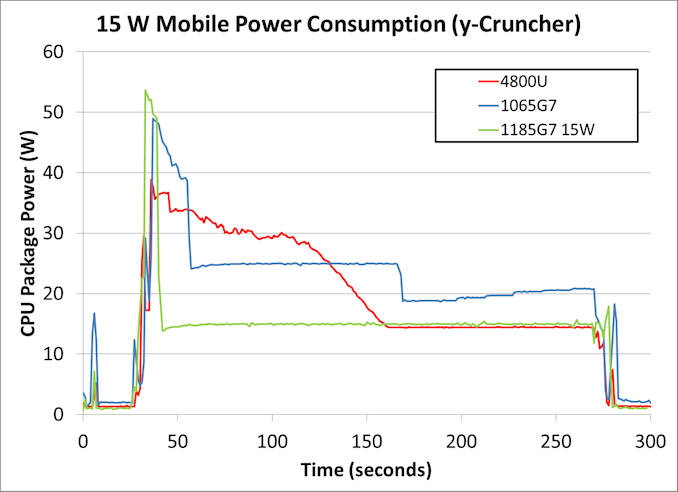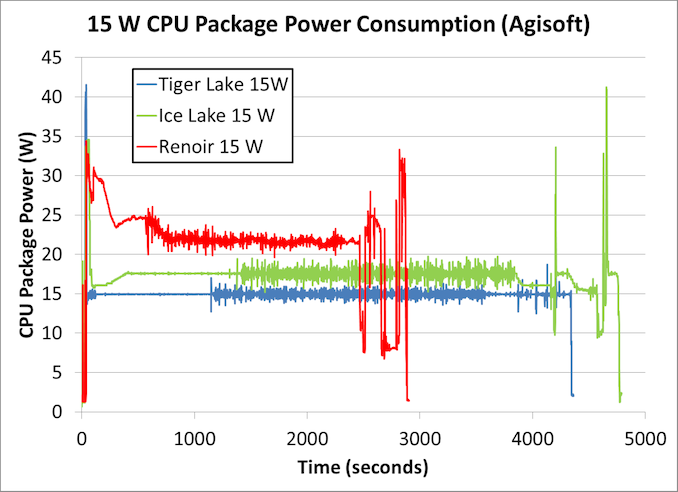Intel’s Tiger Lake 11th Gen Core i7-1185G7 Review and Deep Dive: Baskin’ for the Exotic
by Dr. Ian Cutress & Andrei Frumusanu on September 17, 2020 9:35 AM EST- Posted in
- CPUs
- Intel
- 10nm
- Tiger Lake
- Xe-LP
- Willow Cove
- SuperFin
- 11th Gen
- i7-1185G7
- Tiger King
Comparing 15 W TGL to 15 W ICL to 15 W Renoir
Despite the hullaballoo with the 28 W numbers on Tiger Lake, we suspect that most OEMs will still be positioning the hardware inside chassis built for the 15 W ultraportable market. This is where most of Intel’s OEMs have had success over the last decade, as the lower cooling requirements allow for a more user-friendly design. At 28 W, there is more of a cross-over into laptops that have discrete graphics options, and the main company that has succeeded in offering 28 W laptops without discrete graphics has been Apple - most Intel partners, if they want discrete graphics, end up looking at the 45 W processors with more cores.
So in that respect, our main battle should occur between the products built for 15 W. To that end we have been able to put the three together that will command this holiday season’s offerings: Ice Lake, Tiger Lake, and AMD’s Renoir.
- For our Ice Lake system, we have the Microsoft Surface Laptop 3. This has the top-of-the-line quad-core Core i7-1065G7, along with 16 GB of LPDDR4X-3733. Base 1.3 GHz, Turbo 3.9 GHz. Because this is an OEM design, Microsoft have determined the PL1 and PL2 values, and so they might be different from a ‘base’ design, however this is data from a real system.
- The Tiger Lake system is our Reference Design from Intel, running the quad-core Core i7-1185G7 at 15 W TDP mode. It has 16 GB of LPDDR4X-4266. Base 1.8 GHz, Turbo 4.8 GHz.
- Our AMD Renoir system is one of the most premium examples of AMD’s Ryzen Mobile in a 15W form factor, the Lenovo Yoga Slim 7 with the eight-core Ryzen 7 4800U processor. Even when set to the highest performance mode, the system still operates with a 15 W sustained power draw. It comes equipped with 16 GB of LPDDR4X-4266. Base 1.8 GHz, Turbo 4.2 GHz.
Compute Workload
For our 15 W comparisons, we can look again at the same benchmarks as the previous page. First up is y-Cruncher, an AVX2/AVX512 compute workload that tasks the CPU and the memory by calculating 2.5 billion digits of Pi, and requires ~11 GB of DRAM.
As we saw on the previous page, our Tiger Lake system in green at 15 W turbos up to ~53 watts before very quickly coming down to 15 W for the rest of the test.
The Microsoft Surface Laptop 3, by virtue of an OEM system, has different behavior - it turbos for longer, settles into a short turbo limit of 25 W, and then after about two minutes comes down to 20 W. The system then appears to opportunistically up the power draw until the end of the test, likely due to detecting extra thermal headroom.
The AMD Renoir processor does not turbo as high, peaking at only 38.9 W. Over the course of the next 100 seconds or slow, we see a small ramp down to just under 30 watts, before a more consistent decline over 30 seconds to 15 W, before staying at 15 W for the full test. The Renoir here has eight cores rather that four, but is running AVX2 rather than AVX-512 code.
The results are as follows:
- Ice Lake: 233 seconds, for 6072 joules, averaging 26.1 W
- Tiger Lake: 241 seconds for 4082 joules, averaging 17.0 W
- Renoir: 234 seconds for 5386 joules, averaging 23.0 W
All three systems perform the test in roughly the same amount of time, however the Tiger Lake system is very much ahead for efficiency. Tiger Lake effectively shaves off a third of the power from the previous generation Ice Lake system. We weren’t expecting this much of a jump from Ice Lake to Tiger Lake, but it would appear that Intel has done some work on the AVX-512 unit, and is putting that new high-performance transistor to use.
Professional ISV Workload
Moving onto the Agisoft test - as mentioned on the previous page, this is a 2D image to 3D modeling workflow where the algorithm comes in four stages, some of which prefer full multi-thread throughput, while others are more frequency and memory sensitive.
First, the Renoir finishes in almost half the time, mostly due to the fact that it has double the number of cores - there is no AVX-512 codepath in this test, and so all the processors rely on a mix of SSE, AVX, and perhaps some AVX2. That aside, the turbo behavior of Renoir is very interesting - we get almost 10 minutes of higher-than-base performance before the algorithm sets into a routine, hovering around 22 W. Because this test doesn’t attack the vector units as hard as the previous test, it may be a case that the Renoir system can manage the power distribution a bit better between the eight cores, allowing for the higher turbo.
Between the Ice Lake and the Tiger Lake, from the graph it would appear to be a double win for Tiger Lake, finishing in a shorter time but also consuming less power. The results are:
- 15 W Renoir: 2842 seconds for 62660 joules
- 15 W Ice Lake: 4733 seconds for 82344 joules
- 15 W Tiger Lake: 4311 seconds for 64854 joules
In this case, it’s a win for Renoir - a lot shorter time, and better power to boot, derived from the eight cores built on TSMC 7nm. Tiger Lake still represents a good jump over Ice Lake, offering 10% better performance at only 79% of the power, or a 13% increase in performance efficiency.












253 Comments
View All Comments
JayNor - Thursday, September 17, 2020 - link
I noted from Intel's Thunderbolt 3 documents that the ports are bidirectional and can, for example, support pcie send while receiving display port on the same cable.Is it possible, for example, to use an external GPU card with one cable to display output on your laptop's display?
Spunjji - Friday, September 18, 2020 - link
I understand that you can, but it drops performance significantly.Spunjji - Thursday, September 17, 2020 - link
Oof, those GPU benchmarks are painful. It's become clear that their predictions were all based on LPDDR5PeachNCream - Thursday, September 17, 2020 - link
Yes the GPU results are somewhat disappointing, but there is only so much you can do when sharing bandwidth to RAM with the CPU cores and everything else. Of course, there is also significant latency to contend with when you don't have GDDR5/6 available to the graphics processor.Spunjji - Friday, September 18, 2020 - link
Absolutely - it's become pretty clear that's why AMD decided to go with 8 CUs on Renoir. I wasn't expecting anything huge from Xe on TGL, but Intel were pushing it as a big win and really it's just not - at least, not in this form. A ~20% bandwidth boost might well translate into big gains on later devices.JayNor - Saturday, September 19, 2020 - link
false, they used lpddr4x for the benchmarks.Spunjji - Saturday, September 19, 2020 - link
I think perhaps you misread what I said. Intel were previously showing numbers suggesting a huge leap in performance for their Xe iGPU which isn't borne out by the testing done here. I'm suggesting that it's because Intel were quoting numbers based on an LPDDR5 implementation. They could have just been lying, though. You seem to be suggesting the latter?undervolted_dc - Thursday, September 17, 2020 - link
Ok but why there are no power consumption of the ryzen ? I see a 28w tiger lake which have a peak of 50+ and an average of 35 and another "28w" tiger lake which instaed have a peak of 50+ and an average of 38w..,is the 4800u in thermal throttling because the tiger lake is better cooled ? this "reference" and the lack of real power usage comparision is "strange" to me... we started from the intel benchmarks.. and now we hare here ... where will be in 1 more months when the tiger lake will be in stores with also it's prices.. will be still comparable to the 4800u? ( and I'm also sure that asus will not cover air intake for the tiger lake one to be able to sell them against the 4800u given the higher prices they have to ask .. )
and where we will be then when zen3/cezanne will be revealed ? you will see the zen3 ipc and freq gain in 1 month.. ( maybe even before tiger lake approach stores ) .. I see no Baskin here..
undervolted_dc - Friday, September 18, 2020 - link
Also ram is unfair for this comparison:intel LPDDR4X-4266
vs amd DDR4-3200
but again.. at the end of the day the only thing that matter is the price/performance/power-usage balance for laptop, and here I see only performance comparison..(in unknown thermal/power condition for tests) and with no words about price..
we see here a coming-soon quad core intel with a power usage higher than 1 year old 8 core amd which is also faster in full speed tests ( not in gpu , but it's the old navi chip )
yes, single core bench the intel win.. but their high freq single core are 20% higher freq than AMD ones, are 20% faster, and eat 50% more power , are ~1 year newer , and probably will costs 50% more.. so who is the real winner?
undervolted_dc - Friday, September 18, 2020 - link
a mere 4500u with lpddr4x show an average +17% improvements in benchmarks..https://optocrypto.com/amd-ryzen-4000-adding-suppo...